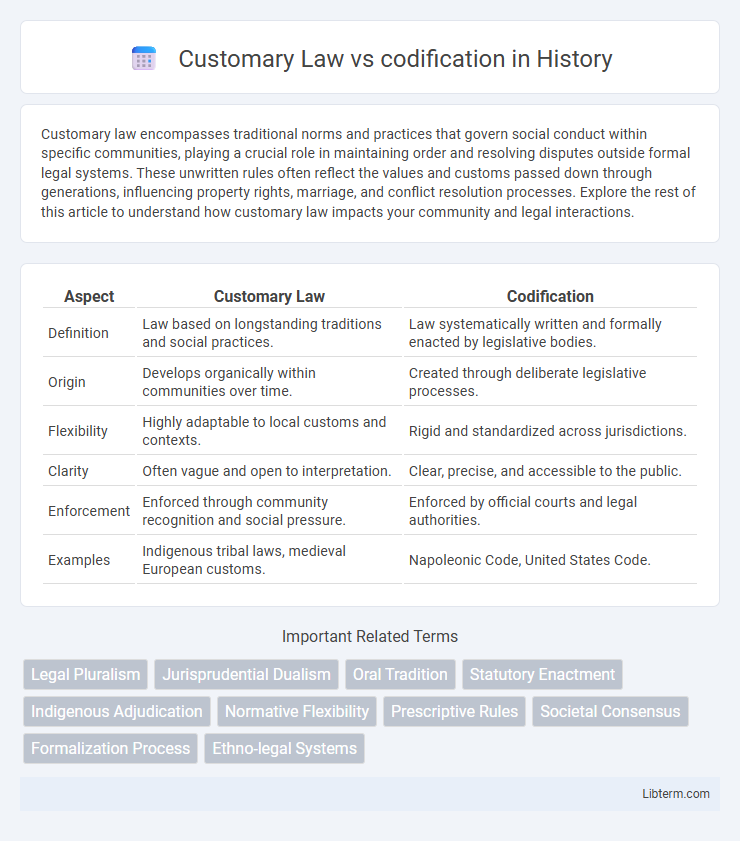Customary law encompasses traditional norms and practices that govern social conduct within specific communities, playing a crucial role in maintaining order and resolving disputes outside formal legal systems. These unwritten rules often reflect the values and customs passed down through generations, influencing property rights, marriage, and conflict resolution processes. Explore the rest of this article to understand how customary law impacts your community and legal interactions.
Table of Comparison
| Aspect | Customary Law | Codification |
|---|---|---|
| Definition | Law based on longstanding traditions and social practices. | Law systematically written and formally enacted by legislative bodies. |
| Origin | Develops organically within communities over time. | Created through deliberate legislative processes. |
| Flexibility | Highly adaptable to local customs and contexts. | Rigid and standardized across jurisdictions. |
| Clarity | Often vague and open to interpretation. | Clear, precise, and accessible to the public. |
| Enforcement | Enforced through community recognition and social pressure. | Enforced by official courts and legal authorities. |
| Examples | Indigenous tribal laws, medieval European customs. | Napoleonic Code, United States Code. |
Introduction to Customary Law and Codification
Customary law refers to the body of unwritten rules and practices that develop organically within communities, reflecting their traditions and social norms. Codification involves the formal process of consolidating these customs into written statutes to ensure clarity, uniformity, and enforceability within a legal system. Understanding the interplay between customary law and codification is essential for appreciating how traditional practices adapt to modern legal frameworks.
Historical Development of Customary Law
Historic development of customary law traces back to unwritten practices and traditions that governed societies long before formal legal systems emerged. It evolved organically through community consensus, reflecting social norms, customs, and local values, distinguishing it from codification, which involves systematically documenting laws in written form. Codification began gaining prominence during the 18th and 19th centuries as states sought uniformity and clarity in legal systems, contrasting sharply with the flexible and adaptive character of customary law.
The Evolution of Legal Codification
The evolution of legal codification reflects a systematic shift from the fluidity of customary law toward structured and accessible written statutes. Codification organizes legal principles into comprehensive codes, thereby enhancing consistency, predictability, and enforceability in legal systems worldwide. This transformation enables societies to balance traditional practices with the demands of modern governance through clear, standardized legal frameworks.
Key Differences Between Customary Law and Codification
Customary law evolves from established practices and social norms within communities, reflecting unwritten rules shaped by tradition and cultural values. Codification systematically compiles laws into formal, written codes designed to provide clarity, uniformity, and accessibility in legal systems. A key difference lies in flexibility; customary law adapts organically over time, while codified law requires formal legislative processes for modification.
Advantages of Customary Law in Modern Societies
Customary law offers adaptability by evolving through community practices and social norms, ensuring relevance in diverse cultural contexts. Its informal nature fosters accessibility and local dispute resolution without the need for complex legal procedures. This flexibility enhances social cohesion by reflecting shared values and promoting justice rooted in tradition rather than rigid legal codes.
Benefits and Drawbacks of Legal Codification
Legal codification provides clarity and accessibility by systematically organizing laws into written statutes, enhancing consistency and predictability in judicial decisions. However, codification may lack flexibility, potentially failing to adapt quickly to evolving societal norms compared to customary law's organic development. The rigidity of codified laws can limit judicial discretion, causing challenges in interpreting ambiguous situations that customary law might address more fluidly.
Case Studies: Customary Law vs Codified Law in Practice
Case studies illustrating the clash between customary law and codified law reveal significant challenges in jurisdictions like Nigeria and South Africa, where indigenous practices often conflict with statutory regulations. In Nigeria, customary law governs personal matters such as marriage and inheritance for many communities, yet codified laws sometimes override these traditions, causing legal uncertainty and social tensions. South Africa demonstrates hybrid legal systems where courts strive to harmonize customary norms with constitutionally mandated rights, highlighting the practical complexities of integrating unwritten customs into formal legal frameworks.
Challenges in Harmonizing Customary Law with Codification
Harmonizing customary law with codification presents challenges such as conflicting principles between oral traditions and written statutes, leading to legal ambiguity and enforcement difficulties. The diversity of customary practices complicates creating uniform codes that respect local customs while ensuring consistency in application across jurisdictions. Legal systems struggle to balance the flexibility of customary law with the rigidity of codified rules, often resulting in disputes over interpretation and authority.
The Future of Customary Law Amidst Legal Reforms
Customary law remains a vital component of legal systems in many countries, particularly in rural and indigenous communities where it reflects local traditions and social norms. As legal reforms and codification efforts progress, challenges arise in harmonizing customary practices with statutory laws while preserving cultural identity and justice. The future of customary law hinges on adaptive frameworks that integrate customary norms into formal legal systems through recognition, documentation, and inclusive policymaking.
Conclusion: Striking a Balance Between Custom and Code
Striking a balance between customary law and codification requires integrating the flexibility of customary practices with the clarity and consistency of written codes. Codification provides a standardized legal framework that enhances predictability and enforcement, while customary law retains cultural relevance and adaptability to local contexts. Harmonizing these approaches fosters a legal system that respects tradition while promoting fairness and uniformity.
Customary Law Infographic

 libterm.com
libterm.com